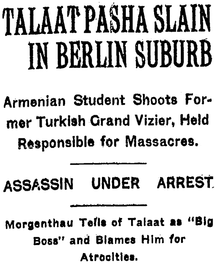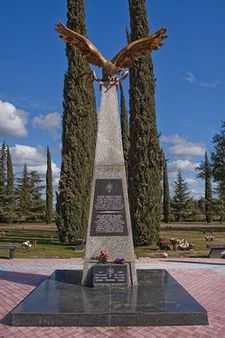Soghomon Tehlirian
| Soghomon Tehlirian | |
|---|---|
 Tehlirian in 1921 | |
| Born |
April 2, 1896 Nerkin Pakarich, Vilayet of Erzurum, Ottoman Empire |
| Died |
May 23, 1960 (aged 64) San Francisco, California, United States |
Resting place | Ararat Cemetery, Fresno, California |
| Ethnicity | Armenian |
Political party | Armenian Revolutionary Federation |
Soghomon Tehlirian (classical Armenian: Սողոմոն Թեհլիրեան; April 2, 1896 – May 23, 1960) was an Armenian Genocide survivor who assassinated the former Ottoman Grand Vizier Talaat Pasha in the presence of many witnesses on March 15, 1921 in Berlin as revenge for his role in orchestrating the Armenian Genocide during World War I. It was a part of the Operation Nemesis by the Armenian Revolutionary Federation. Talaat Pasha had been convicted and sentenced to death in absentia in the Turkish Courts-Martial of 1919–1920 for his crimes against the Armenians of the Empire (among other things). After a two-day trial Tehlirian was found not guilty by the German court and freed. Tehlirian is considered a national hero by Armenians.[1][2]
Life
Soghomon Tehlirian was born on April 2, 1896 in the village of Nerkin Bagarij, in the Erzurum villayet of Western Armenia.[3] Tehlirian's father left for Serbia to secure the family's planned move to the country.[3] After his return in 1905, he was arrested and sentenced to six months imprisonment. During this time, the Tehlirian family moved from Nerkin Bagarij to Erzinjan.[3] Tehlirian received his initial education at the Protestant elementary school in Erzinjan.[3] After graduation at the Getronagan (Central) Lyceum of Constantinople, he went to study engineering in Serbia and had plans to continue his education in Germany.[3][4] He was in Valjevo, Serbia at the time of the assassination of Archduke Franz Ferdinand in June 1914.[5]
Genocide
In the fall of 1914, Tehlirian made his way to Russia and joined the army to serve in a volunteer unit on the Caucasus Front against the Turks.[6] In June 1915, the Ottoman local police ordered the evacuation and deportation of all the Armenians in Erzinjan. Tehlirian's mother, three sisters, his sister's husband, his two brothers, and a two-year-old niece were deported.[7] All told, Tehlirian lost 85 family members to the Armenian Genocide.[8]
In 1921 he joined Operation Nemesis, a covert assassination program that would target the architects of the Armenian Genocide.
Assassination

Tehlirian's main target was Talaat Pasha, who was a member of the military triumvirate known as the "Three Pashas" who controlled the Ottoman Empire. He was the former Minister of the Interior and Grand Vizier (an office equivalent to that of a prime minister), and was noted for his prominent role in the Armenian Genocide. As soon as he found Talaat Pasha's address, Tehlirian rented an apartment near his house so that he could study his everyday routine.[3][9] Talaat was killed by Tehlirian with a single bullet on March 15, 1921 as he came out of his house on Hardenbergstrasse, in the Charlottenburg district of Berlin.[10] The assassination took place in broad daylight and led to Tehlirian's immediate arrest by German police.[10]
Trial
Tehlirian was tried for murder, but was eventually acquitted by the German court. His trial was a rather sensationalized event at the time, with Tehlirian being defended by three defense attorneys, including Dr. Theodor Niemeyer, professor of law at Kiel University, priest and Armenian Genocide survivor Grigoris Balakian, activist Johannes Lepsius, and German commander of the Ottoman armed forces during the war General Liman von Sanders were among several of the prominent individuals called as witnesses to the trial.
The trial examined not only Tehlirian’s actions but also Tehlirian's conviction that Talaat Pasha was the main author of the Armenian deportation and mass killings. The defense attorneys made no attempt to deny the fact that Tehlirian had killed a man, and instead focused on the influence of the Armenian Genocide on Tehlirian's mental state. When asked by the judge if he felt any sort of guilt, Tehlirian remarked, "I do not consider myself guilty because my conscience is clear…I have killed a man. But I am not a murderer."[1]
During his trial, Tehlirian claimed that while he was in Weimar Germany, he saw his mother in his dreams who scorned her son for seeing Talaat Pasha and not having taken revenge yet.[11] During the trial, Tehlirian's dream was described as follows:[12][13]
He remained calm, and thoughts of vengeance did not occur to him.
He carried on as before until five to six weeks later, when he saw a dream,
materially almost like a vision. His mother’s corpse arose before him. He
told her, “I saw Talaat.” His mother answered, “You saw Talaat and you did
not avenge your mother’s, father’s, brothers’, and sisters’ murders? You are
no longer my son.” This is the moment when the defendant thought, “I have
to do something. I want to be my mother’s son again. She cannot turn me
away when I go to be with her in heaven. I want her to clasp me to her
bosom like before.”
As the doctors explained, the dream ended when he woke up.
It took the jury slightly over an hour to render a verdict of "not guilty."[1]
Later life

After the assassination, Tehlirian moved to Serbia and eventually married Anahit Tatikian who was also from Erzincan.[15] During his days in Serbia, Tehlirian was a member of the shooting club and was considered a skilled marksman.[15] The married couple moved to Belgium and lived there until 1945, when they moved to San Francisco.[4]
Tehlirian died in 1960 and is buried at the Ararat Cemetery in Fresno, California. Tehlirian's monument-grave is an obelisk with a gold-plated eagle slaying a snake on top. It is reported that the original artist of the monument was quoted as saying that the eagle was "...the arm of justice of the Armenian people extending their wrath onto Talaat Pasha," who was symbolized by the snake.[1] The monument itself is centered in the middle of the cemetery with a walkway made of red brick surrounded by cypress trees.[1]
Legacy
The trial influenced Polish lawyer Raphael Lemkin, who later reflected on the trial, "Why is a man punished when he kills another man? Why is the killing of a million a lesser crime than the killing of a single individual?"[16]
Political theorist Hannah Arendt, in her 1963 book Eichmann in Jerusalem, compares Tehlirian to Sholom Schwartzbard, who assassinated Ukrainian statesman Symon Petliura in Paris in 1925 for what Schwartzbard believed to be Petlyura's culpability in the anti-Jewish pogroms in Ukraine. Arendt suggests that each man "insisted on being tried", in order "to show the world through court procedure what crimes against his people had been committed and gone unpunished."[17]
[T]he one in the center of the play, on whom all eyes are fastened, is now the true hero, while at the same time the trial character of the proceedings is safeguarded, because it is not "a spectacle with prearranged results" but contains that element of "irreducible risk" which... is an indispensable factor in all criminal trials. Also, the J'accuse, so indispensable from the viewpoint of the victim, sounds, of course, much more convincing in the mouth of a man who has been forced to take the law into his own hands than in the voice of a government-appointed agent who risks nothing. And yet... it is more than doubtful that this solution would have been justifiable in Eichmann's case, and it is obvious that it would have been altogether unjustifiable if carried out by government agents. The point in favor of Schwartzbard and Tehlirian was that each was a member of an ethnic group that did not possess its own state and legal system, that there was no tribunal in the world to which either group could have brought its victims.[17]
Several statues of Tehlirian have been erected in Armenia. His first statue in Armenia was inaugurated in 1990 in the village of Mastara.[18]
In 2014, Tehlirian's story was told in a graphic novel, Special Mission: Nemesis.[19]
Film adaptation
- The 1982 American film Assignment Berlin, directed by Hrayr Toukhanian, accurately chronicles Talaat Pasha's assassination in Berlin.
- The French film Mayrig (1991) by Henri Verneuil depicts Talat's assassination and Tehlirian's trial.
- Tehlirian's trial was adapted in the Turkish film Blood on the Wall, a largely inaccurate portrayal.
See also
References
- ↑ 1.0 1.1 1.2 1.3 1.4 Vartabedian, Sarah (2007), "Commemoration of an Assassin: Representing the Armenian Genocide," Unpublished University of North Carolina at Chapel Hill Thesis, p. 7.
- ↑ Von Voss, Huberta (2007). Portraits of Hope: Armenians in the Contemporary World. New York: Berghahn Books. p. 6. ISBN 9781845452575.
- ↑ 3.0 3.1 3.2 3.3 3.4 3.5 Derogy, Jacques (1990). Resistance and Revenge: The Armenian Assassination of the Turkish Leaders Responsible for the 1915 massacres and deportations. New Brunswick, NJ: Transaction Publishers. p. 65. ISBN 9780887383380.
- ↑ 4.0 4.1 "AGMI received rare photos of Soghomon Tehlirian". Genocide Museum. Retrieved 12 December 2012.
- ↑ (Armenian) Tehlirian, Soghomon. Վերյիշումներ [Recollections], Cairo: Husaper, 1956, pp. 43-44.
- ↑ Tehlirian, Recollections, pp. 45-48.
- ↑ Cummins, Joseph (2006). History's Great Untold Stories: Larger than Life Characters & Dramatic Events that Changed the World. Washington D.C.: National Geographic. p. 301. ISBN 9781426200311.
- ↑ Tehlirian, Recollections, p. 8.
- ↑ "Soghomon Tehlirian". Ararat (Armenian General Benevolent Union of America) 31. 1990. Retrieved 25 May 2013.
- ↑ 10.0 10.1 Totten, Samuel; Bartrop, Paul R. (2008). Dictionary of genocide (1. publ. ed.). Westport, Conn. [u.a.]: Greenwood Press. p. 418. ISBN 0313346445.
- ↑ Vartabedian, "Commemoration of an Assassin."
- ↑ "Official Trial of Soghomon Tehlirian". Cilicia. German Government. Retrieved 25 May 2013.
- ↑ Yeghiayan, Vartkes (ed.) (2006). The Case of Soghomon Tehlirian (2nd ed.). Glendale: Center for Armenian Remembrance. ISBN 0977715310.
- ↑ Սողոմոն Թէհլիրեանի Յուշարձանի Պատմականը. Asbarez (in Armenian). 9 January 2012. Retrieved 21 February 2014.
- ↑ 15.0 15.1 "Along Armenian Footsteps in Serbia". Armenian Weekly. Retrieved 25 May 2013.
- ↑ January, Brendan (2007). Genocide: Modern Crimes Against Humanity. Minneapolis: 21st Century Books, p. 24.
- ↑ 17.0 17.1 Arendt, Hannah (1963). Eichmann in Jerusalem: A Report on the Banality of Evil. New York: Viking Press, pp. 265-66.
- ↑ Սողոմոն Թեհլերյանի արձանն ուխտատեղի էր ռազմաճակատ մեկնող տղաների համար (in Armenian). Yerkir Media. 17 March 2015.
- ↑ "From victim to avenger," Editions Sigest
Further reading
- Bass, Gary Jonathan. Stay the Hand of Vengeance: The Politics of War Crimes Tribunals. Princeton University Press, 2001.
- Bogosian, Eric. Operation Nemesis: The Assassination Plot that Avenged the Armenian Genocide. New York: Little, Brown & Company, 2015.
- Ihrig, Stefan. "Genocide Denied, Accepted, and Justified: The Assassination of Talât Pasha and the Subsequent Trial as a Media Event in the Early Weimar Republic," Journal of the Society for Armenian Studies 22 (2013), pp. 153-77.
- (Armenian) Tehlirian, Soghomon. Վերհիշումներ [Recollections], Cairo: Husaper, 1956.
- Yeghiayan, Vartkes. The Case of Soghomon Tehlirian. Glendale, CA: Center for Armenian Remembrance; 2nd edition, 2006.
External links
|
| ||||||||||||||||||||||||||||||||||
| Wikimedia Commons has media related to Soghomon Tehlirian. |